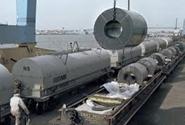Prices

March 14, 2017
AIIS: January 2017 Steel Exports
Written by Brett Linton
US steel exports rose in January according to the latest data analysis by the American Institute for International Steel. The press release from AIIS follows:
Falls Church, VA. March 13, 2017. Steel exports started the year off strong, increasing 12.6 percent from December to January.
The 818,431 net tons of exports were 4.6 percent higher than the January 2016 total. Exports to Canada swelled 22.6 percent during the month to 407,286 net tons, a 4.1 percent increase from a year earlier, while exports to Mexico expanded by 8.2 percent to 331,901 net tons, 11.3 percent higher than the previous January.
Exports to the European Union fell 38.5 percent from December to 18,874 net tons, which was nearly unchanged from the first month of last year.
While many specific details of the Trump Administration’s trade agenda are understandably lacking—the nominee for United States Trade Representative has not even been confirmed by the Senate—we know enough at this point to have significant concerns. Some of these concerns arise from the recent release of a draft document outlining broad aspects of the Administration’s trade agenda. The draft document appears to indicate that the United States will pursue policies in the World Trade Organization and elsewhere that diminish the importance of the international rules-based trading system that the United States helped create and has led for seven decades. History shows that limiting United States leadership in the global trading arena is never a good idea. In addition, the draft trade agenda indicates that the United States will focus largely on bilateral trade negotiations, rather than multilateral agreements. While bilateral agreements can certainly be useful tools for liberalizing trade and creating jobs, there are many practical problems with focusing just on this approach. For example, no European country that is a member of the European Union has legal authority to negotiate its own trade deal with the United States, or with anyone else. Another major concern is that the Administration’s trade agenda appears to also focus on reducing imports, including imports of steel. Many of these key imports are used as intermediate goods in the United States, and limiting their access would create a strong headwind for economic growth. It is important to remember that trade is a two-way street. If the United States acts to limit imports of steel and other products, other nations will almost certainly respond in kind, and limit our exports to their markets. Protectionism is a lose-lose proposition.







